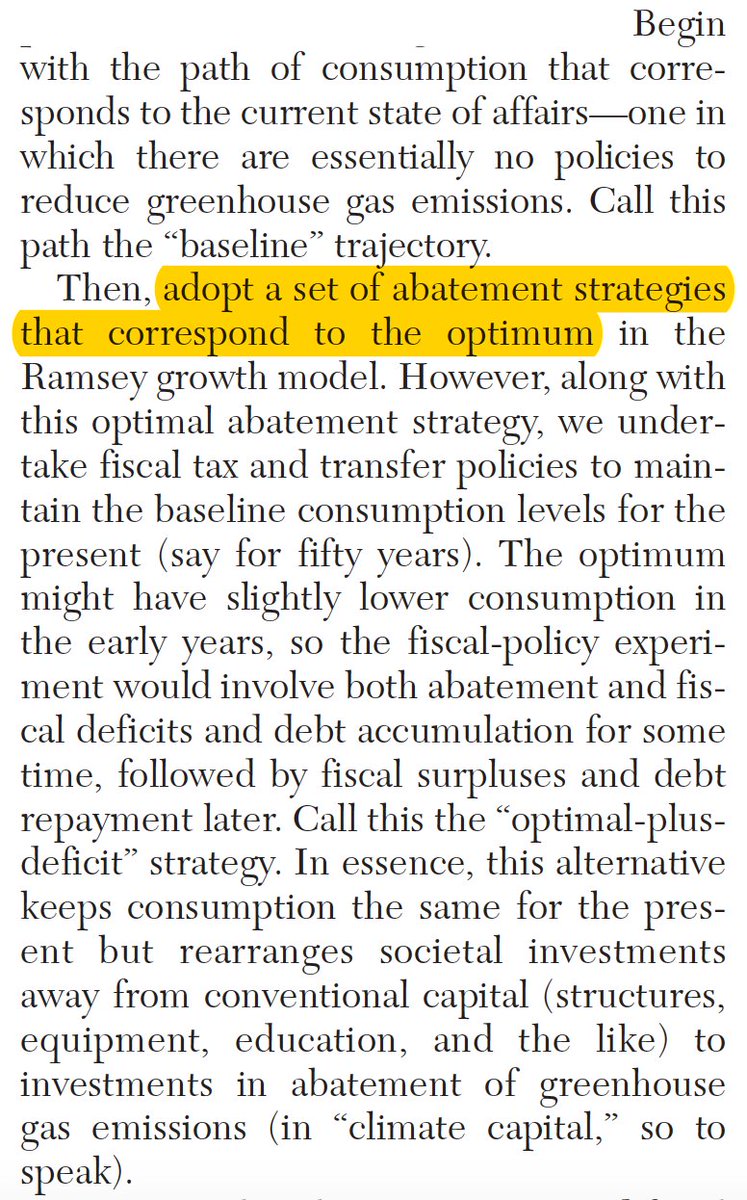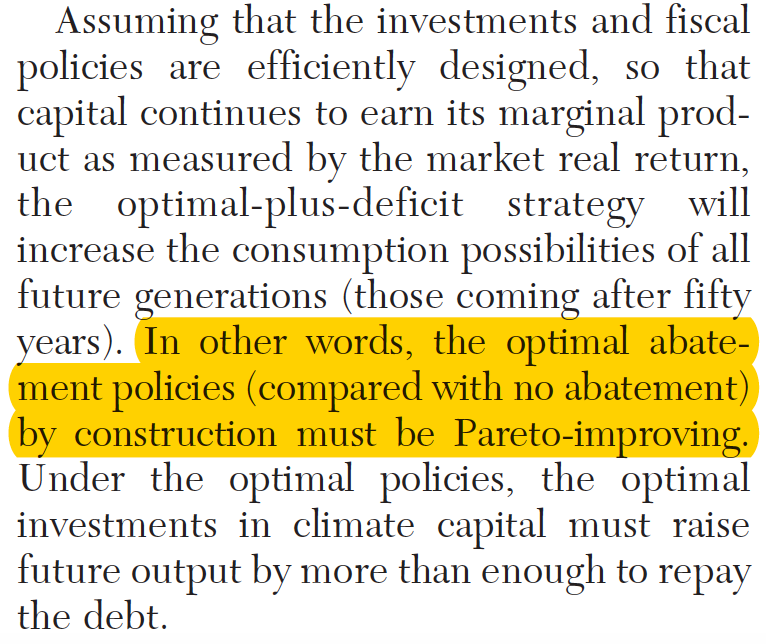MEGATHREAD: I tweeted some quick thoughts yesterday about this new paper but I wanted to follow up with a more thoughtful take. Yesterday I griped that the paper’s numbers omitted the co-benefits of CO2 mitigation, & that the relevance of co-benefits were noted only the end. https://twitter.com/PatrickTBrown31/status/1306244493583118336">https://twitter.com/PatrickTB...
I want to set those gripes aside and engage with the paper at the level the authors clearly wish for it to be engaged with, namely at the conceptual level. I should have begun with that yesterday, and I apologize to the authors for pouncing rather than engaging.
The authors introduce the concept of “the break-even year”. As I read the paper, this concept—which I am glad to have the opportunity to think about!—is defined problematically three times before the clearest and most useful definition is given.
In the paper’s opening abstract, the break-even year is defined as ”the year when the economically optimal [CO2 mitigation] policy begins to produce global mean net economics benefits.”
On p. 2, the break-even year is characterized as the year “when emissions reduction policies become economically beneficial.” Later on p. 2 it is characterized as the year “when climate change mitigation begins to produce net economic benefits.”
So why are these definitions problematic? They are problematic because as usually understood in climate econ, a mitigation action has “net economic benefits” just in case its monetized benefits exceed its costs. And even if the benefits are in the future, …
… it can still be true that today’s costs are lower than the mitigation action’s benefits. So on the usual definition of “producing net benefits,” a unit of mitigation today can in fact produce net benefits even when the relevant benefits will occur in the future.
It turns out that the authors are not concerned to identify the year in which mitigation “produces net benefits” in this conventional sense from climate economics. They have something quite distinct in mind.
The authors’ most careful and (I suggest) official definition of “break-even year” is: “the year when net global per-capita consumption, under economically optimal policy, begins to exceed net per-capita consumption under a no-policy case” (p. 2).
In other words, the break-even year for a given mitigation policy is the year in which the average person living in that year would see their living standards improve *in absolute terms* as compared to what their living standards would have been under a do-nothing policy.
The authors are interested in the break-even year because they want us to understand why a mitigation policy that’s deemed optimal for a *society* might not be deemed optimal (in the normal English sense of the term) by the *individuals* who must pay the costs of mitigation.
As they put it, a policy that is in “humanity’s” or the “perpetual global society’s” best interest may not be in the best interest of every individual or “discrete generation of people” who’d have to pay mitigation costs under a policy deemed optimal by a global social planner.
I think the authors are quite correct to stress this potential divergence between what’s in humanity’s collective interest & what’s in the interest of the average person living today. It’s why I wanted them to highlight the air-quality co-benefits that mitigation can bring today.
But even setting co-benefits aside (as I’m going to do now), I want to push back against the underlying assumption that *any* future year is “the” break-even year. And here, dear readers, is where we descend into the weeds. (OK, OK: here is where we get *really* weedy.)
The authors use Bill Nordhaus’s DICE model to perform their analysis. A lot has been said by a lot of people about the DICE model, but one thing that doesn’t get said enough is that different economists use DICE in radically different ways.
One way to use DICE is “to calculate the policy that would be put into place by an omniscient utilitarian social planner whose goal is to maximize global human well-being”. That is how the authors of this Break-Even paper think of DICE (the quote is theirs from p. 2).
But that is not how Nordhaus says *he* uses it (although it does match his less disciplined *rhetoric* about his results). In his more reflective remarks, he makes it clear that he uses DICE to *describe* real-world behavior, and not to *normatively evaluate* various policies.
(Those quotes are from p. 1110 and 1111 of this paper, which is the most important and revealing paper of Nordhaus’s, IMHO: http://econdse.org/wp-content/uploads/2012/04/Nordhaus_Integrated_Assessment_Models_Handbook_2013.pdf)">https://econdse.org/wp-conten...
One of the key questions Nordhaus aims to answer with his non-normative use of DICE is: Is the business-as-usual status quo inefficient *in the sense that* it would be possible improve future people’s consumption via mitigation while fully compensating those who’d mitigate today?
And, in fact, whenever the answer to that question is Yes, it is also possible to make mitigation a strict win/win, improving the consumption of both the average future person and the average person today.
And that is exactly what Nordhaus says is possible, given that his model—or, rather, his *use* of his model—identifies some degree of mitigation above the current amount as “optimal”. This is from his review of the _Stern Review_ (p. 695). http://www.colby.edu/economics/faculty/thtieten/ec476/Nordhaus.pdf">https://www.colby.edu/economics...
What this means is that when one uses Nordhaus’s DICE model *in the way he uses it*, then the “optimal emissions path” is the one that could be part of the most beneficial win/win climate policy.
Importantly, when one uses DICE as Nordhaus uses it, there is absolutely no basis for the claim that it is desirable to impose costs today for the sake of benefits later. The modeling exercise is simply not equipped in that case even to address that normative issue.
All it can do is tell us what is *possible*. And the most consistent result from Nordhaus is that *any* year—including this year—could be a break-even year, if we coupled mitigation today with intergenerational redistribution.
(Here are two papers about how that intergenerational redistribution could be carried out: http://users.ox.ac.uk/~sfop0060/pdf/World%20Climate%20Bank.pdf">https://users.ox.ac.uk/~sfop0060... https://www.nottingham.ac.uk/climateethicseconomics/documents/papers-workshop-2/jaakkola-et-al.pdf.">https://www.nottingham.ac.uk/climateet... The second paper is co-authored by @NikoEcon.)
Now, if one uses DICE instead to find a normatively optimal mitigation path, then this paper’s findings definitely apply: the break-even point will be a point in the future, and perhaps far into the future, depending on your chosen functional forms and parameter values.
So in the end I agree w/ the authors that the break-even year idea is important, especially as we try to move the climate policy needle. And in fact, they explicitly encourage thinking creatively about how we might hasten climate policy by moving the break-even year forward.
Yet at the conceptual level, I do just want to stress: every single time an economic model has been used to run the sort of analysis Nordhaus himself uses DICE to run, it has shown that the break-even year can be *this year*, if we want it to be.
That is unfortunately not something that the paper communicates. This omission is also related to an unfortunate use on p. 2 of the idea of a tragedy of the commons, which the authors use to depict a tension between what’s best for society vs. what’s best for each individual.
But the real lesson from analyzing the idea of a tragedy of the commons is that what is best for society can in principle make every individual better off, too. That is what Nordhaus’s results have shown since 1991, and it’d be great if more people knew that.
For an additional perspective on why there need be no intergenerational conflict in climate policy, see this paper from @MarkVinPaul: https://twitter.com/MarkVinPaul/status/1306328545011138562">https://twitter.com/MarkVinPa...
https://twitter.com/F_Errickson/status/1306601343474335744">https://twitter.com/F_Erricks...

 Read on Twitter
Read on Twitter






